programming – Wolfram 1
CA ca; // An instance object to describe the Wolfram basic Cellular Automata
void setup() {
size(640, 360);
int[] ruleset = {0,1,0,1,1,0,1,0}; // An initial rule system
ca = new CA(ruleset); // Initialize CA
background(0);
}
void draw() {
ca.render(); // Draw the CA
ca.generate(); // Generate the next level
if (ca.finished()) { // If we’re done, clear the screen, pick a new ruleset and restart
background(0);
ca.randomize();
ca.restart();
}
}
void mousePressed() {
background(0);
ca.randomize();
ca.restart();
}
class CA {
int[] cells; // An array of 0s and 1s
int generation; // How many generations?
int scl; // How many pixels wide/high is each cell?
int[] rules; // An array to store the ruleset, for example {0,1,1,0,1,1,0,1}
CA(int[] r) {
rules = r;
scl = 1;
cells = new int[width/scl];
restart();
}
// Set the rules of the CA
void setRules(int[] r) {
rules = r;
}
// Make a random ruleset
void randomize() {
for (int i = 0; i < 8; i++) {
rules[i] = int(random(2));
}
}
// Reset to generation 0
void restart() {
for (int i = 0; i < cells.length; i++) {
cells[i] = 0;
}
cells[cells.length/2] = 1; // We arbitrarily start with just the middle cell having a state of "1"
generation = 0;
}
// The process of creating the new generation
void generate() {
// First we create an empty array for the new values
int[] nextgen = new int[cells.length];
// For every spot, determine new state by examing current state, and neighbor states
// Ignore edges that only have one neighor
for (int i = 1; i < cells.length-1; i++) {
int left = cells[i-1]; // Left neighbor state
int me = cells[i]; // Current state
int right = cells[i+1]; // Right neighbor state
nextgen[i] = executeRules(left,me,right); // Compute next generation state based on ruleset
}
// Copy the array into current value
for (int i = 1; i < cells.length-1; i++) {
cells[i] = nextgen[i];
}
//cells = (int[]) nextgen.clone();
generation++;
}
// This is the easy part, just draw the cells, fill 255 for '1', fill 0 for '0'
void render() {
for (int i = 0; i height/scl) {
return true;
} else {
return false;
}
}
}
Checking In
Hi hello, is this thing on?
I haven’t actually used this in a while and want to know how many of you read this. I’m thinking of pulling the pin on this, but also kinda want to use it as a way to share content that is cool.
Comment below.

A look into my mind…
I want to write this down
That above is literally a quote from myself. The point of writing “this” down is so that I’m actually writing. It’s not for anything or anyone, it’s for myself.
What a chapter to finish. Moving away from home at 18 never did I think I’d be sitting in a free roadside (brand new leather might I add) couch in a house decorated by me (including StarWars every second wall hanging). When you’re accepted into university you kinda assume you do it so that you can get yourself together, I’m here to say it’s not together at the end, but that’s half the adventure. Think of it as a duck swimming in water, everything looks smooth sailing. Your marks flow, your network grows, but for this to happen your feet need to work the whole time paddling really fast under the water.
I build drones in my bedroom, I fly them and I want to change the world using them. I’m a design thinker and believe you can only really know your practise by doing it literally right in front of you. This all sounds fantastic and you’re probably thinking, that is all well and good now that I’ve taken the risk and it paid off, but I want to advocate its possible.
I’m a small country town kid. I had no idea what it was I was going to do after school, but knew two things. Firstly, that I wanted to help people. I didn’t think doctor, because I wasn’t good at biology, chemistry, advanced maths in the HSC. However, helping people whether it made life easier, safer and generally happier. Secondly, that a fortune teller once told my mother that I would help people, take that as you will (believer or not). That was my only criteria to move to university. So I sat the HSC with no real nerves because I had so many people say it’s not the be all end all, and I believed it. Strangely enough, as my peers freaked out and told me completely different answers to my own in most of the exams I sat, I was okay throughout. I didn’t assume anything, I didn’t expect anything.
To keep context, I passed my HSC at around a credit equivalent average but thought I wanted to be involved in filmmaking, the arts, theatre, photography…storytelling. I wanted to tell my story. What a blessed period of time we live in that we can access devices that capture moments that tell our story. I was accepted into university off an audition process for a performance degree. This was wonderful. I was physically and emotionally pushed in classes and unlocked a confidence I wouldn’t have known without it. When asked why I left, I simply detail that what I tried, and am doing now, I love more. I still go and watch my close friends shows in Sydney and have a close connection to theatre.
What a change. I want to blog about the specifics of what it is I’ve done with drones, but this is sparked by a major decision I’ve made. Throughout my 3 years in Communications and Media Studies at UOW, I’ve finished. Done. Now on the hunt for what it is I get to give back to the world. It comes back to the point about helping people. I want to help people with technology and honour a value of hard work. I am hands on and I want to build things over and over until it’s right. Anyone can do this. Look up what it is that grabs the attention, and understand it. Watch hours of tutorials on YouTube, again and again. Even if you don’t have the financial means to purchase the product, watch unboxings, read reviews, look up the instruction manuals online and read it. This is exactly what I did before I built my drone. I knew the thing inside and out before I even thought about purchasing the parts to build it. When I finally got in touch with the people that I needed to about funding, I was ready for any of their questions. Done to the last colour combination of propellor. My “thing” just happened to be drones. But it could be anything.
I haven’t covered a lot of what I was going to reading back over this, but perhaps it’ll give me something to do while I’ve managed to gain crutches. I want to open up a space for those to gain an insight into a university life, opportunity, hardship and triumph. To take a look into my mind while also getting it in writing. It is therapeutic for such an over-active mind like mine.
Stay posted.
Sam
Final Statement and Installation
“Software < Hardware”, Installation, 2017
A work that explores the nature of technology and perhaps reverses the idea that we are a disposable culture when it comes to the devices we interact with everyday. The work incorporates technology that was overtaken by another technology that physically made it dead. Scattered around are Walkmans that were made redundant by MP3 download,, TVs that were left when digital antennas meant the analogue channels were cut off, and iPhones that with regular iOS enhancements that meant working devices were become slow and inconsistent. So is what’s killing technology and any future development the software element? Forcing the consumer e to purchase a new one and discard the original. Would you part with your phone if it would still work in 10 years time?This is something that I feel if some people didn’t HAVE to change, they wouldn’t. So I believe this works on a digital level. The digital software is perhaps what’s halting a lot of technology. So I looked into a technology that uses an abundance of software to perform the newest forms of technology and I stumbled into 3D printing.
3D Printing utilises millions of lines of code that are then programmed into a piece of hardware that releases a physical form. So my question is, as a technology that uses so much software to operate, can it survive? or will it be the destruction of so many other things we’ve had to now rely on photos or memories to enjoy?
Sam Noakes 4759485
BCM311 Reflection
When writing for a blog which I aligned with university and used as an academic showcase never did I think I’d be talking about myself. As a performance audition successful applicant to graduating with a Bachelor of Communications and Media degree, this university thing we are encouraged to do has allowed me to be looking into fields that aren’t an actual title yet. To work with people that have skill-sets beyond our imagination yet the opportunity to collaborate and create trajectories that will change the world, one class that I’m going to share my thoughts on is a class that 14 weeks ago I was never going to take, and now rate with the reason I can safely say, it’s going to be okay leaving.
This is an excerpt from an essay I just wrote concerning the changing nature we face as a collective on the future of work. Now I say collective with the focus of University students. With changing situations, values and narratives coming from student situations this semester I was able to reflect on my own situation. I was able to interview someone whom I’ve formed close friendship with simply because of similar mindsets, and completed a class that tempted (without success) the idea of honours, simply because I’m not afraid to own my achievements.
To reflect and theorise on the trajectory of a professional career, firstly a focus must be shown on an individual value. Perhaps the most interesting method to understand and self-reflect is to approach a stranger, or person that isn’t well-known personally, but who you feel you can relate to and contribute with. This was a key moment when I was personally trying to understand the way working professionally has shifted from permanent to ‘gig’-like and what I then have to consider moving forward. I personally believe this model can be applied to a lot of disciplines and is perhaps why I personally resonated with the way of thinking. I approached a professional who has taught me a design thinking mindset within a tertiary setting. The opportunity to reflect on some of my glorious failures within a university atmosphere that isn’t focused on much else moving forward besides statistical marks, was liberating when he detailed that he wants to see more like this. Being able to publish works that haven’t worked and actively build on them with real world application feedback will showcase a head start into what he believes is the future of work for my degree, and that others should take note. I would submit an assignment with the outcome a failure, but the ability to then reflect on why it failed and apply it to the next prototype would infact be a method of teaching that resonates with entrepreneurial qualities. Now, interestingly enough, when on the verge of leaving the institution, I’m showcased to narrative practices and forming a connection with my own values and experience near narrative to shape my direction. The idea of telling my story of a series of events about how I got to a position within a engineering focused future, wasn’t how established norm would have cracked a market. For context, I’m a media and communications student trying to crack a niche market in drone technology, whereby I built a custom prototype using YouTube and Online forums to then pitch to engineering companies. Already, this isn’t an orthodox mix, however this very value of unorthodox practices has allowed opportunity within organisations that haven’t yet recognised the need for reflective practice.
BCM311 allows students the freedom the workplace and real life throws at you. Submission deadlines, class absence, safe spaces and perhaps attitudes towards hard work were all major stand out points that made this experience a refreshing time. Everything that the inertia scares me about the longevity of certain changes to work, this class compliments. I’ve never been too personal about life and detailed a lot, but it’s simply because I thought it fell under that inertia bracket of “professional VS. personal”.
Where the future of work is headed is simply the understanding of both within the workplace. Everyone has a story, and narrative practice simply gives the humility in people a chance to resonate and act on. We in media and communications sometimes seem unneeded in some disciplines, however we’re amongst the first implementing this narrative practice along with psychology. I’ll be the first to promote the awareness and addressing of mental health in the workplace from engineering, healthcare and the arts. The sustainability of the future of working environments relies on peoples well-being, and narrative reflection, practice and methodology starts with myself, as a media practitioner with the skills now in listening for these values in another person. It’s a gift, and it’s apart of a CV of achievements. I hope I can help others like I’ve always wanted to, and this gives me another foot in the door.
It’s been a pleasure, and not one drone was harmed in the completion of this class.
TESTING
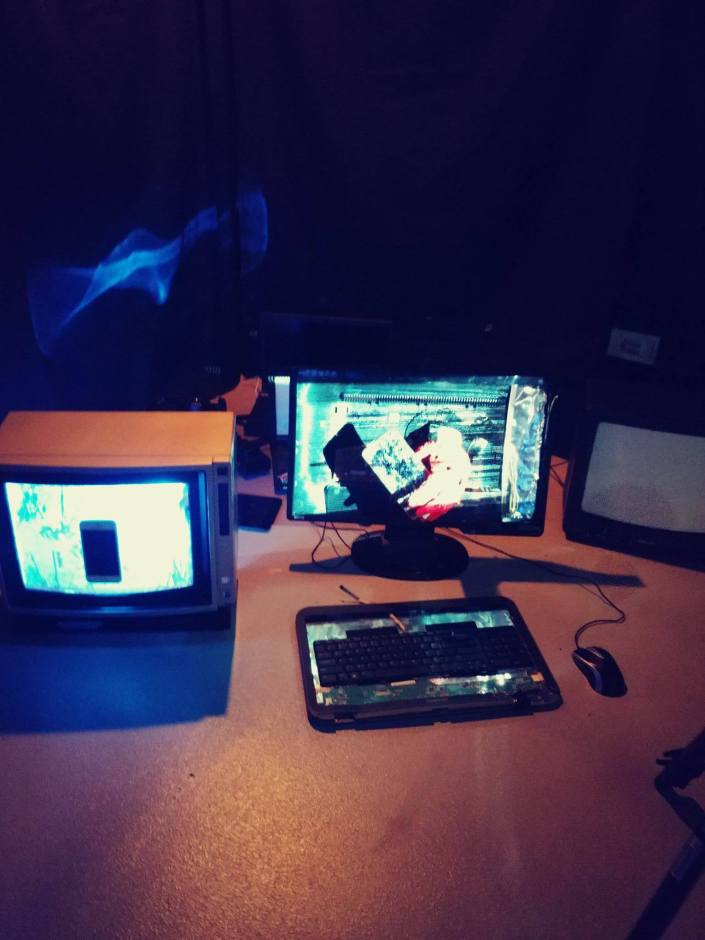
Item list:
2x Kumi projectors: each playing a set of code on loop. The projection onto the 3D printed artefact is a code from one of the components that is then sent to a printer to be turned into the physical. The second projection then comes through from behind onto a tv with a iPhone glued to the screen. The projection is an apple update that was the last update I downloaded onto it that eventually caused it to run slowly and eventually not turn on. This was the last apple update i performed before switching to android.
The tv at the back right + strobe: strobe sits in the bottom right corner to showcase static unresponsiveness. That was the last TV I had that was affected by the switch to digital TV channels and could no longer run off the analogue channel providers. This was made unusable through digital upgrades.
Miscellaneous Tech: scattered at the back…ownership of each of the items have been replaced by another due to software or digital upgrades.
process & showcase MEDA302
This new approach see’s the physicality of the effects of updates from internal software. I want to dive into the questions surrounding the capitalist mindset of some companies within technology and what this means for future ownership of devices. And then are these implications going to surround all new technologies.
For context, the idea that I’m very sentimental with my devices has got me thinking about what it is about certain elements of technology and devices that people look and empathise with me. This can be cameras, phones, audio equipment, basically anything that was later replaced by something more digital. eg. Phones were replaced by touch screen phones, walkmans replaced by ipods, ipods inevitably replaced by phones, PCs replaced by laptops again replaced by phones. The hardware still operates okay, as we see with people returning to old hardware such as vinyl records to keep the nostalgia alive.
So is what’s killing technology and any future development the software element? To focus on one particular device, the iPhone. The software updates have become known to be used by the company so that eventually the phone will run slower and the apps will not work unless you do so, causing you in shorter and shorter amounts of time to purchase a new one and discard the original. This is something that I feel if some people didn’t HAVE to change, they wouldn’t. So I believe this works on a digital level. The digital software is perhaps what’s halting alot of technology. So I looked into a technology that uses an abundance of software to perform the newest forms of technology and I stumbled into 3D printing.
3D Printing utilises millions of lines of code that are then programmed into a piece of hardware that releases a physical form. So my question is, as a technology that uses so much software to operate, can it survive? or will it be the destruction of so many other things we’ve had to now rely on photos or memories to enjoy?
Week11: 3d printing is the next to go…
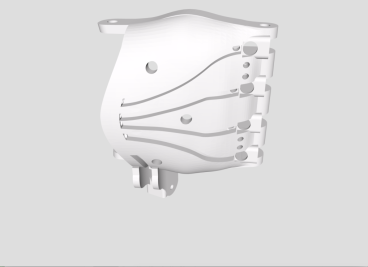
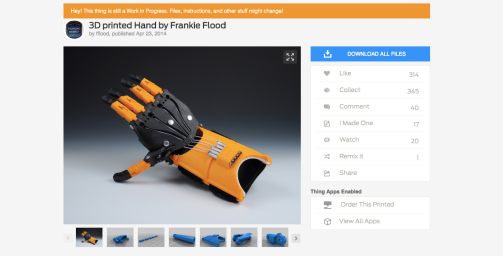
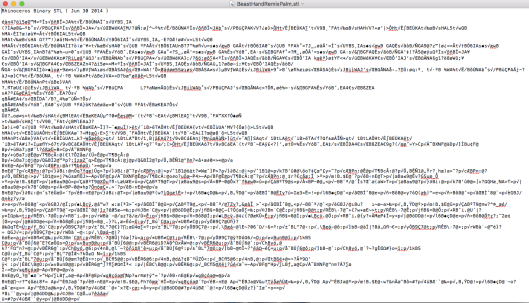
So a development in idea process. Instead of a mannequin-like set up that is showcasing technology dying into itself, I’m focusing on a particular technology that is new, but will end up dead. 3D Printing.
Everyone says how this is the next big thing, but track record of emerging technology suggests otherwise. I want to showcase this physically. Take out the mannequin hand that is looking for the next technology to sabotage, and use my 3D printed prosthesis. Then with the kumi, project onto the hand the STL code from the file I got it with. Essentially, the 3D printed hand is a piece of code taken a physical form. This will act as a catalyst for the humanisation of a device.
The dead technology will still sit behind it, however the idea is that the 3D printing phenomena is the “killer” in the momentum of futures. The STL code will loop over a period of time to show all components that go into the piece. The question I want to address is how can we stop this trend? Is a trend of the new futures going to be how quickly we can move onto the next emerging technology?
Iteration and installation will happen next week, this week I just sat within the space and literally looked at the devices. Questioned the motifs behind what it really is I want to understand and was really effective. I want to mind map this all out and basically just throw it up. The aesthetic nature comes last now.
week10: technology updates technology
The direction for this installation has gotten me thinking about what it is I want to showcase in this work. Originally the idea I wanted to tangle with, was the notion that technology goes back and forth in iteration, in design, in trends and in functionality. I like the idea that the departure point for this last project was “futures”, and my immediate response was to showcase something that’s framed in the past. I think this is the basis of the work I want to display.
As non-human object, the technological devices we carry everyday constantly run at a pace determined by us. That, meaning they’re only function is determined by our use of them. Autonomy within them are seemingly not far away with the small increments being added to smartphones, however we can still choose most of their function. The thing that is seemingly out of our control though now is the way they’re manufactured to be replaced by the next evolution of the same thing. This leads most to expect another criticism of Apple, however I want to go perhaps a little more broad with examples like the Record – MixTape – CD – MP3 evolution. Or the Film – VHS – DVD – Streaming trajectory of technology that include perhaps require a whole new hardware component to access content. Without discouraging the thought of this, nowadays this seems to have come t a relatively smaller halt, but the upgrades coming WITHIN the device, as a software update.
Consumers now are faced with a device that is in perfectly fine working order, in that it turns on, runs and connects them to content at a leisure. However to gain more or perhaps the most recent available services, the individual must update the device. NOTE: I’m going to be using the smart phone/tablet for this example as it is the most relatable for me. Once the software is updated, the phone has basically been given a no returns sentence. The update is designed to target newer app downloads, but also “laggs” the phone, decreases its swift functionality and tells the story of the device ultimately needing an upgrade.
Something this week that I want to explore is perhaps the trail effect or reckless understanding we have of this. Using the devices from my past, as a reminder of how much this trend of keeping updated and connected, leads to a media archeology of functioning devices that are tossed aside. Perhaps we wish we could stick to the one mobile phone or the one DVD player, but industry doesn’t allow us to. There’s possibility for batteries in devices to last 3 weeks, however corporate bosses don’t allow this to happen. Is there humanity to these devices that ultimately leads to its era ending?
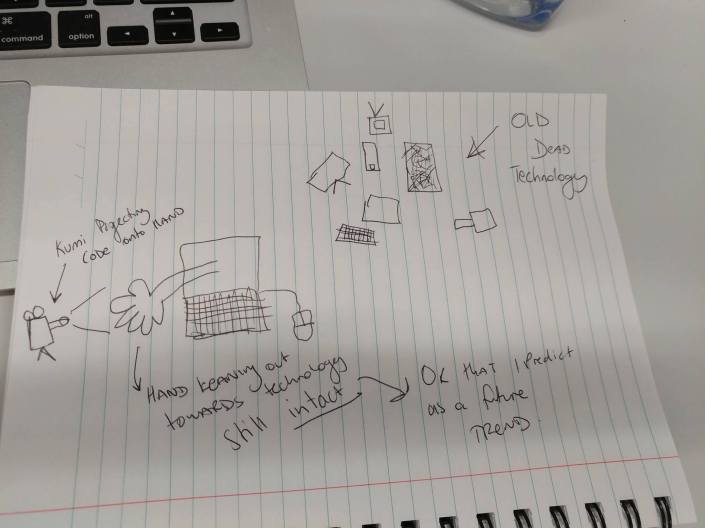
week9: fail early fail often…or something like that
FEFO as it’s commonly known.
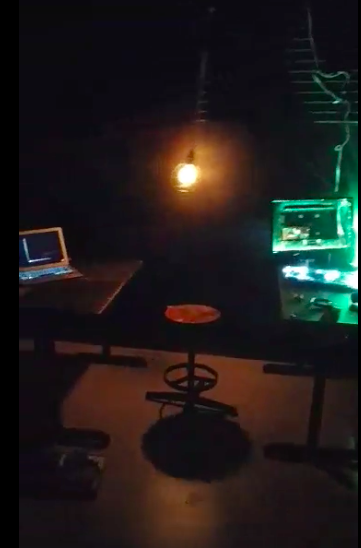
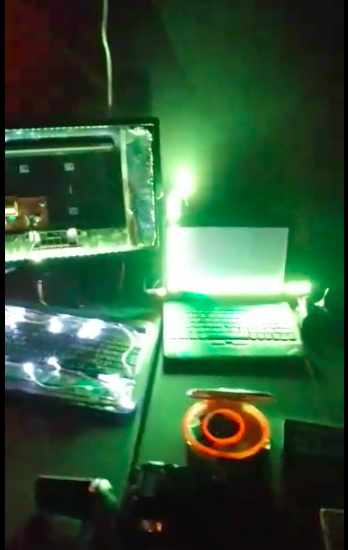
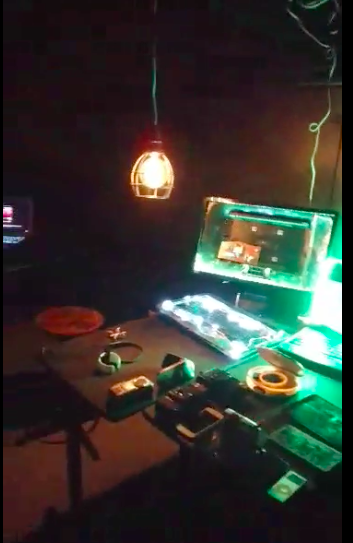
Simple fact. It didn’t work. It didn’t showcase what I needed it to. It didn’t convey a sense of nostalgia. It didn’t ask questions of why we are attached to technology. It simply just didn’t resonate with people and again gave off the impression of a workshop/hoarding set up that was filled with Xmas lights and cheaply assembled LED lights.
Thats okay. I’ve got a backup idea to try. Same direction of how we dispose of the technology quickly, this time instead of asking what it is that makes us attached to things, this time i’m asking the question is it the technology within thats making these devices disposable. Is it the embedded marketing within websites and product launches that actually makes us subconsciously upgrade and dispose. Is the idea of AI not a being that can think walk and talk, but switch and make us switch devices at will.
I want to tangle with the idea of automation. Not in that we switch something on and leave it to wander for itself, but within the idea of automatic response. Automatic trajectory of devices, that things are built to break quickly and we just abide this because these machines tell us to.
Stay tuned. Broken tech still stays. LEDs go.




